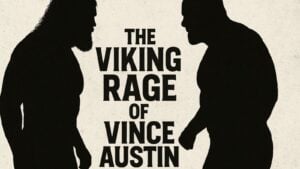David vs. Goliath, Kobashi and Takayama, the giant vs. the smaller underdog—it’s a time-tested trope in pro-wrestling. It has been done countless times across promotions around the world.
Many wrestlers and wrestling promotions have tried to create the perfect version of this story only to come up short in one way or another.
But today we look back at the one match that really did live up to that billing and set new standards for what it means.
It took place on April 25th, 2004, in Pro Wrestling NOAH. And today we revisit that legendary encounter.
Meet The Fighters
David
Kenta Kobashi is widely considered to be the greatest professional wrestler in modern times, if not ever. Tokyo Sports once called him ‘the perfect wrestler’ and there was plenty of evidence to support that.
He looked like John Cena, wrestled like Kurt Angle, absorbed damage like Mick Foley, and possessed Shawn Michaels-level charisma. Even today, many of Kobashi’s singles and tag matches rank among the best of the best.
In 2004, Kobashi was in the middle of his iconic Reign of Excellence. A year earlier, he beat his longtime rival Mitsuharu Misawa to finally surpass him and win the GHC Heavyweight Championship.
Since then, Kobashi has faced a wide variety of challengers: an Olympic-level grappler, an American who outpowered him, two of the biggest stars from rival company New Japan, a scrawny junior who tried to win via cheating and cheap tricks, a rising star, and a former cruiserweight turned heavyweight.
One by one, all of them fell to Kobashi. Each one of them had their own unique way of trying to dethrone the champion, but none of their strategies worked in the end.
No matter how daunting the task, Kobashi never wavered. He was the heroic David that overcame the odds that this story needed.
But what would happen when his next challenger was basically a Frankenstein’s monster that combined various elements of all the previous challengers into one person?
Goliath
In a country where the average male height is 5 foot 7.2, 6 foot 5 Yoshihiro Takayama was/is a literal giant.
He towered over every other wrestler around him with few exceptions like Giant Baba, Akebono, and other sumo wrestlers. But in the world of pro wrestling, Takayama was Goliath.
But he didn’t just get this reputation due to size alone; he was widely considered the toughest wrestler in Japan, if not the world, at the time.
Wrestling enthusiasts and journalists were calling Takayama the toughest wrestler in the world for his ability to take an inhuman amount of physical punishment and keep going.
He was considered tougher than certified legends like Misawa, Kawada, Taue, Akiyama, Dr. Death, Vader, Stan Hansen, the list goes on.
Though he had taken many savage beatings pro-wrestling that created that reputation, it was this mixed martial arts fight that proved it.
At PRIDE 21, Takayama fought Frye in what is still considered one of the best and most famous bouts in MMA history. Even though he was completely outmatched in terms of skill, Takayama kept going.
His face got completely pummeled, to the point that it literally started to resemble a potato. But Takayama kept going and lasted over six minutes, which was far longer than anyone ever expected.
As if his size and toughness weren’t enough challenges for Kobashi, there was a third problem for the champion: Takayama’s submission expertise.
Even though he looked like another prototypical lumbering giant, Takayama was well-versed in submission mat wrestling. He trained in UWFi, which was a shootfighting promotion that emphasized real/realistic holds.
So when he locked in a cross armbreaker or a heel hook, it was treated far more seriously than if a non-submission expert (like Kobashi) did the same thing.
So Kobashi not only had to deal with a wrestler that was both bigger and tougher than him. But he also had to deal with a wrestler that was well-versed in amateur grappling and submission martial arts.
Takayama ended up being a mix of two types of prototypical fighters: he was both the stronger and tough giant and the clever grappler with a smart strategy. Needless to say that Kobashi was at a severe disadvantage going into this match.
Kobashi and Takayama – The Match
Takayama had the advantage from the very beginning. He was one of the very few wrestlers that were able to both out-power Kobashi on a lock-up and brush off Kobashi’s punishing strikes.
Realizing what he was in for, Kobashi quickly applied his own strategy by attacking Takayama’s neck with chops and submission holds.
Since most of Kobashi’s biggest moves targeted the neck, it made perfect sense for him to soften that body part up to make it easier to land a finishing blow.
Kobashi continued this approach with a DDT onto the ringside mats and then went for a suplex but Takayama countered into a guillotine choke that stopped Kobashi’s momentum dead in its tracks.
From there, Takayama bodied Kobashi and threw him around like a rag doll while also hitting different running strikes that showed surprising speed from a man of his size.
Kobashi fought through and tried to ignore the pain caused by Takayama and even tried to boot Takayama to stop his constant charging.
But Takayama was one step ahead and caught Kobashi’s leg, which he proceeded to kick with all his might.
Just like that, Takayama slowed Kobashi down and took away his ability to run and lift. So Kobashi relied on right-hand chops…until Takayama smashed Kobashi’s right arm between his elbow and his massive knee.
It was as if Kobashi’s arm had been pinched by an industrial-strength vice. The referee had to check on him to see if he could continue.
Kobashi wouldn’t take a count-out loss or surrender from pain; he had to fight on. But now that he was completely vulnerable, Takayama did the smartest thing he could do: he went after Kobashi’s arm even more.
Kobashi basically became a one-armed man in an ass-kicking contest, especially after he resorted to a sudden rebound lariat on the floor. He downed Takayama momentarily but hurt himself even more in the process.
He couldn’t even use his right arm to hold onto the ropes, which made it easier for Takayama to hit an Everest German suplex from the apron to the floor.
Once back in the ring, it became a true gladiatorial fight to the death. Kobashi had only one working arm, but he had to rely on both to get around Takayama’s guard. He even resorted to head-butts, knowing it was all he could do at that moment.
Everything became a titanic struggle for Kobashi, especially as Takayama continued to target his bad arm. And once Takayama locked in a cross armbreaker, many people thought that was the end.
Not only was Kobashi’s right arm almost fractured, but Takayama had much more experience using real submission holds and knew how to lock in like a real MMA fighter.
But what Takayama didn’t expect was for Kobashi to use his own judo experience to escape by rolling towards the ropes. That saved Kobashi, but only for a brief moment.
It wasn’t long before Takayama started wrecking Kobashi even more with stiff knee strikes and Half-Nelson suplexes.
Kobashi was basically a warm body once Takayama landed a bridging German suplex, but somehow Kobashi kicked out. He couldn’t really fight back, but he still had some gas left in the tank.
Takayama tried kicking the soul out of Kobashi’s body when Kobashi caught onto Takayama’s strategy and adapted accordingly.
One blocked corner knee strike opened the door for Kobashi to chop Takayama’s neck into oblivion and start raining neck-dropping suplexes of his own.
Desperate, Kobashi swung for a lariat, only for Takayama to block and land a dragon suplex out of nowhere followed by a knee strike that nearly knocked Kobashi out cold.
Somehow, somehow, Kobashi got to his feet right before the ten-count and connected with not one but two lariats.
But Kobashi knew that wasn’t enough, given both his weakened arm and Takayama’s natural toughness.
He tried one more but Takayama exploded with kicks to Kobashi’s bad knee and a flurry of close-fisted punches as shades of his fight with Don Frye.
But not even hitting so brutally hard could keep Kobashi down. He just couldn’t be killed. Even as Takayama hit him with everything he had, Kobashi fought like a man and powered through.
He smashed Takayama with one big move after another, including another lariat, another Half-Nelson, and somehow, a Sheerdrop Brainbuster.
And when Takayama escaped the Burning Hammer, all seemed lost. Takayama seemed to have an answer for every one of Kobashi’s biggest moves.
Or so he thought.
As the crowd screamed and roared, Kobashi decided to do something he hadn’t done in years. He knew there was only one option left to take out this giant. It started with a simple scoop slam.
And then Kobashi looked to the crowd and made a fist. As soon as he turned his head to the corner, over 16,000 people collectively lost their minds. They were about to witness time-travel in pro-wrestling.
Kobashi managed to turn the block back to 2000 and do something that many people thought was impossible. Something his doctors told him he shouldn’t ever do again. But he did it here. it was his only hope of ending this Goliath.
Kobashi climbed onto the top rope.
He flipped backwards.
And connected with the diving moonsault.
Three seconds later, the bell rang, Kobashi collapsed out of sheer exhaustion, and the fans literally jumped out of their seats. Kobashi had defeated Takayama and retained his title after nearly 30 minutes of incredible wrestling.
Kobashi vs Takayama – Why It’s The Best
The David vs. Goliath trope is widely seen as shorthand for ‘the irresistible force meets the immovable object’. And for the longest time that has meant two unstoppable forces colliding, with one of them simply being too big or too strong for the other to take down.
When most fans hear/read those words, the first image that comes to mind is Hulk Hogan vs. André the Giant, just because of how big (immovable) André was and how determined (irresistible) Hogan was.
But this match is a better version of that story because it’s far more intense and believable. In this match, Takayama (Goliath) wasn’t just some token giant that moved slowly and let his smaller challenger bounce off of him.
Instead, Takayama wrestled smartly. He had a strategy that made total sense: he knew Kobashi couldn’t rely on his usual power advantage and would thus rely on his lariat to try and win the match.
That’s why Takayama targeted Kobashi’s arm to the point that he couldn’t do anywhere near as much damage as he needed to win.
Takayama took out Kobashi’s only reliable source of offense, effectively making it impossible for Kobashi to hit hard enough to keep Takayama down long enough.
Kobashi had no choice but to fight with what few options he had left. Like David, he was at a severe disadvantage. Once Kobashi’s lariat arm was taken out, his chances of winning grew slimmer.
He managed to hurt Takayama but lacked anything strong enough to beat Takayama. His lariats weren’t doing enough damage as a result of Takayama’s arm-targeting strategy.
Takayama was too tough for any kicks or leg drops to do any lasting damage. Takayama kicked out of a Sheerdrop Brainbuster, which was amazing in itself as no one thought Kobashi had enough strength left to pull that off.
And Takayama managed to avoid a Burning Hammer, which would’ve ended him as it had everyone else.
But Kobashi had one secret weapon left. It was a move he hadn’t used in years due to his many surgeries: his moonsault. When Kobashi returned in 2002, no-one thought they’d ever see Kobashi dive off the top rope again.
There was good reason to believe this: he had been using the moonsault as a finisher for over a decade and used his knees for big power moves on a nightly basis.
His knees were described as ‘thrashed’ well over a decade earlier. So when he returned, his entire wrestling style changed so that he wouldn’t need to dive from the top rope anymore.
And for the most part, Kobashi managed to stick with that new style. But he couldn’t do so here. Takayama was basically the perfect opponent for him.
Kobashi couldn’t rely on any of his new tricks. And his usual power advantage was lost on an opponent that was much bigger.
So Kobashi was forced to do something really drastic. He scoop slammed Takayama and went to the top rope. And before he even finished climbing, the audience at Budokan Hall became unglued.
Kobashi had to risk destroying his already-fragile knees with a moonsault press to win. That’s how badly he needed to win and that’s how far he had to go to keep Takayama down.
In doing so, Kobashi demonstrated a resolve that few other wrestlers could or have ever done. He, like David, never wavered in the face of seemingly impossible odds.
And even as his Goliath endured everything he threw at him and nearly crushed him, Kobashi kept going and eventually toppled his mammoth challenger. He had to risk everything to win, and when he did it was the perfect ending.
Kobashi survived not only Takayama’s brutal offense, but he overcame his own limitations. He proved that size doesn’t matter and an opportunity will present itself if you try hard enough.
If there was ever a proper representation of this classic Biblical tale in pro wrestling, it’s this match.







